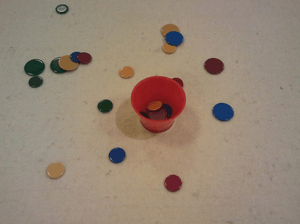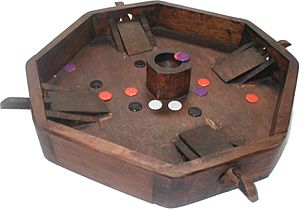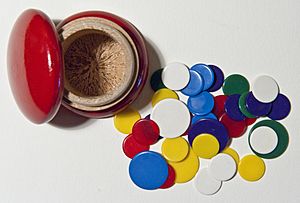Tiddlywinks facts for kids
 |
|
| Years active | 1888 to present |
|---|---|
| Genre(s) | Skill & action game |
| Players | usually 2 or 4; sometimes 3; 6 for a triples match |
| Setup time | 1 minute |
| Playing time | 30 minutes to an hour |
| Random chance | Low |
| Skill(s) required | Strategy, physical skill |
| Synonym(s) | Winks |
Tiddlywinks is a fun game played on a soft felt mat. You use small, flat discs called "winks" and a target called a "pot". To play, you use a special disc called a "squidger" to flick your winks into the air. The goal is to get your winks into the pot to score points.
But there's a trick! You can also stop your opponents from scoring by "squopping" their winks. This means you shoot your wink so it lands on top of theirs. If a wink is squopped, its owner can't play it until it's freed. This makes the game more strategic, like a puzzle!
Some people think tiddlywinks is just a simple game for little kids. But it's actually a very strategic game for adults too! It became popular again at the University of Cambridge in 1955. The modern game has more complex rules and special equipment.
Contents
How to Play Tiddlywinks
Tiddlywinks is played with winks of four different colors: blue, green, red, and yellow. Each player or team controls winks of one or two colors. In a team game, red and blue play together against green and yellow.
There are six winks of each color. They start in the corners of a felt mat, which is usually 6 feet long and 3 feet wide. A pot is placed in the middle of the mat.
There are two main ways to play:
- Pairs Game: Four players work in two teams. Each player uses one color of winks.
- Singles Game: Two players compete against each other. Each player uses two colors of winks.
Players take turns. Your main goals are to:
- Get your own winks into the pot (this is called "potting").
- Cover your opponent's winks (this is called "squopping").
Just like in games like pool, if you pot one of your own winks, you get an extra shot! This means a skilled player can pot all their winks in one turn. Squopping is a key part of the adult game. If your wink is covered by another wink, you cannot play it. But the wink on top can be played! This leads to clever moves where players try to control piles of winks.
The game ends in one of two ways:
- Pot-out: All the winks of one color are potted.
- Time Limit: Play continues for a set time, usually 25 minutes. After time runs out, each color gets five more turns. Then, players are scored based on how many winks they potted and how many were not squopped.
Tiddlywinks Groups
There are two main groups for tiddlywinks players:
- The English Tiddlywinks Association (ETwA)
- The North American Tiddlywinks Association (NATwA)
These groups organize tournaments and keep the rules of the game up to date. The rules are very similar between the two groups. There's also an International Federation of Tiddlywinks Associations (IFTwA) that helps with international competitions.
Tiddlywinks Competitions
In the past, tiddlywinks competitions often involved teams. Now, most competitions focus on single players or pairs (two players). There are still some team matches each year.
The most important tournaments are the National Singles and National Pairs tournaments in England and the United States. There are also World Singles and World Pairs championships. If you win a national tournament, you can challenge the current world champion!
Many other smaller tournaments happen throughout the year. These are often designed to help new players learn the game. The results from all these tournaments help create Tiddlywinks Ratings, which rank players based on their skill.
Skill and Strategy
Tiddlywinks is special because it needs both physical skill and smart thinking. Players often say it combines the hand-eye coordination of games like snooker or golf with the strategy of chess.
The strategy in tiddlywinks can be very deep. Because winks can be captured (squopped), you have to think about what your opponents might do, not just your own moves. Also, the game has a time limit, which adds another challenge.
Unlike games like chess, where every move is planned, tiddlywinks has an element of chance because shots can be missed. This makes the game exciting and less predictable.
Tiddlywinks Equipment
The winks and pots used in competitive tiddlywinks are standard. They are provided by the English Tiddlywinks Association.
- Pots: These are made of plastic and are usually red. They have specific sizes for the top, base, and height.
- Winks: These are made in Italy. They are cut from a long cylinder and then smoothed. This process gives them a very smooth edge, which is important for good play.
- Mats: The mats are made of thick felt. Different mats can feel different, so skilled players learn to adjust their shots.
- Squidgers: Players often make their own squidgers or buy them from special makers. A player can use many different squidgers during a game, choosing the best one for each shot. Top players might have twenty different squidgers! Squidgers are usually made from plastic, but can also be glass, rubber, cork, or onyx. They are often filed and polished to have a sharp edge.
Tiddlywinks Words
Tiddlywinks has its own special language! Here are some terms:
- Blitz: Trying to pot all six of your winks very early in the game.
- Bomb: Shooting a wink from far away at a pile of winks to break it up.
- Boondock: Freeing a squopped wink by shooting it far away, leaving the squopping wink alone.
- Bristol: Moving a pile of two or more winks as one unit. You hold the squidger at a right angle for this shot.
- Carnovsky (US) / Penhaligon (UK): Potting a wink from the baseline (about 3 feet away).
- Cracker (UK): A shot that knocks one wink off a pile and squops it at the same time.
- Crud (UK): A powerful shot meant to completely break up a pile of winks.
- Good shot: Playing a flat wink through a nearby pile to destroy it. Named after John Good.
- Gromp: Trying to jump a pile onto another wink.
- John Lennon memorial shot: A shot that is both a boondock and a squop at the same time.
- Lunch: Potting a wink that was squopped (usually an opponent's wink).
- Scrunge (UK): When a wink bounces out of the pot.
- Squidger: The disc you use to shoot a wink.
- Squop: To play a wink so it lands on top of another wink.
- Sub: When a wink accidentally ends up underneath another wink.
- Tiddlies: Points counted at the end of the game to see who won.
See also
 In Spanish: Pulga (juego) para niños
In Spanish: Pulga (juego) para niños



